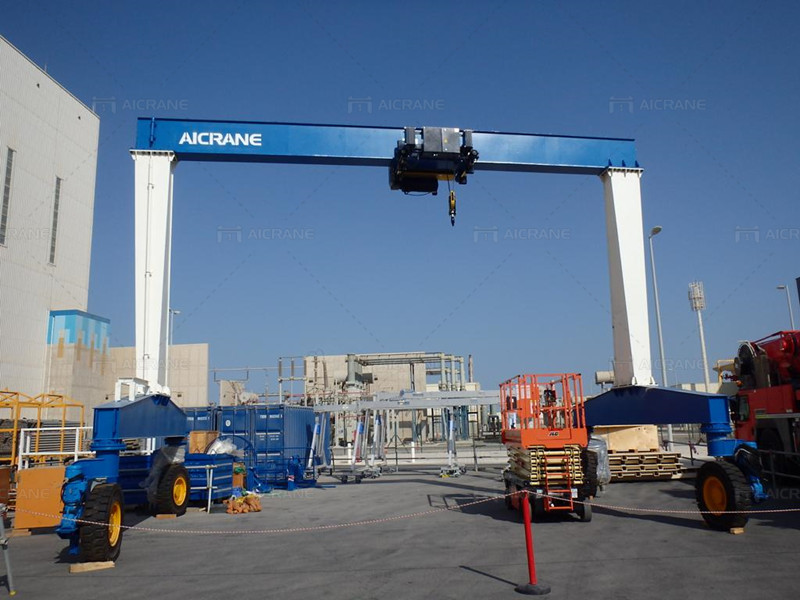Operating a rubber tired gantry is a task that requires precision, skill, and a comprehensive understanding of the equipment. Rubber tired gantrys are commonly used in container terminals for their versatility and mobility. In this guide, we’ll explore four essential steps to efficiently operate a rubber tired gantry, covering pre-operation checks, startup procedures, loading and unloading operations, and safety considerations.

Pre-Operation Checks
Before engaging in any operational tasks, it’s crucial to perform thorough pre-operation checks to ensure the rubber tired gantry is in optimal condition. Start by visually inspecting the entire gantry structure, paying attention to welds, bolts, and structural components. Look for any signs of damage or wear.
Inspect the tires for proper inflation, ensuring they meet the specifications of the crane manufacturer. Check for visible damage, cuts, or uneven wear, as these can impact the gantry’s stability and maneuverability. Verify that the brakes are functioning correctly, and inspect the hydraulic systems for leaks or abnormalities.
Ensure that all control panels and communication devices are in working order. Test the emergency stop system to guarantee its responsiveness. Document any findings and address issues promptly before proceeding to the next phase.
Startup Procedures
Once the pre-operation checks are complete and any identified issues have been addressed, initiate the startup procedures for the rubber tired gantry. Begin by ensuring the gantry is on stable ground and that the brakes are engaged. Follow the manufacturer’s guidelines for starting the engine or motors.
Calibrate the control systems and verify that all instrumentation is displaying accurate information. Check the functionality of the steering mechanism, ensuring that the gantry responds promptly to commands in both forward and reverse directions. During startup, monitor for any unusual noises or vibrations that may indicate potential problems.
Engage the lifting and lowering mechanisms to confirm that they are operating smoothly and that there are no irregularities in load-bearing functions. Once the gantry is fully operational, proceed to the next phase of loading or unloading containers.

Loading and Unloading Operations
The core function of a rubber tired gantry is the efficient loading and unloading of containers in a terminal. When undertaking these operations, it’s essential to follow a systematic approach to maximize efficiency and minimize the risk of errors.
Position the gantry over the designated container, aligning it accurately for the loading or unloading process. Utilize the control systems to lower the spreader and secure it onto the container’s corners. Take note of the weight distribution to ensure stability of the container gantry crane during lifting.
During the lifting process, monitor load capacity indicators and adhere to the specified weight limits. Be cautious of swinging or swaying loads, adjusting the gantry’s position as needed to maintain stability. When placing containers, use precise control to lower them gently onto the designated stack.
For unloading, follow a reverse process, carefully lifting containers from stacks and placing them onto the designated ground or transport vehicles. Communicate effectively with ground personnel and other operators to coordinate movements and maintain a smooth workflow.
Safety Considerations and Shutdown
Safety is paramount when operating heavy equipment like rubber tired gantries. Constant vigilance and adherence to safety protocols are critical throughout the operation. Operators should be trained in emergency procedures, including the use of emergency stops and evacuation protocols.
Maintain clear communication with ground personnel and other operators, especially during busy periods. Be aware of your surroundings and watch for potential obstacles or hazards. Regularly check blind spots using mirrors or cameras to ensure a clear operating path.
After completing the loading or unloading operations, initiate the shutdown procedures. Safely park the rubber tired gantry crane on stable ground, engage the brakes, and power down the engine or motors. Perform a final visual inspection to identify any issues that may have arisen during the operation.
Mastering the operation of a rubber tired gantry involves meticulous pre-operation checks, precise startup procedures, efficient loading and unloading operations, and unwavering attention to safety. By following these four essential steps, operators can ensure the smooth and effective use of this versatile equipment in container terminals and contribute to the overall efficiency of cargo handling operations.